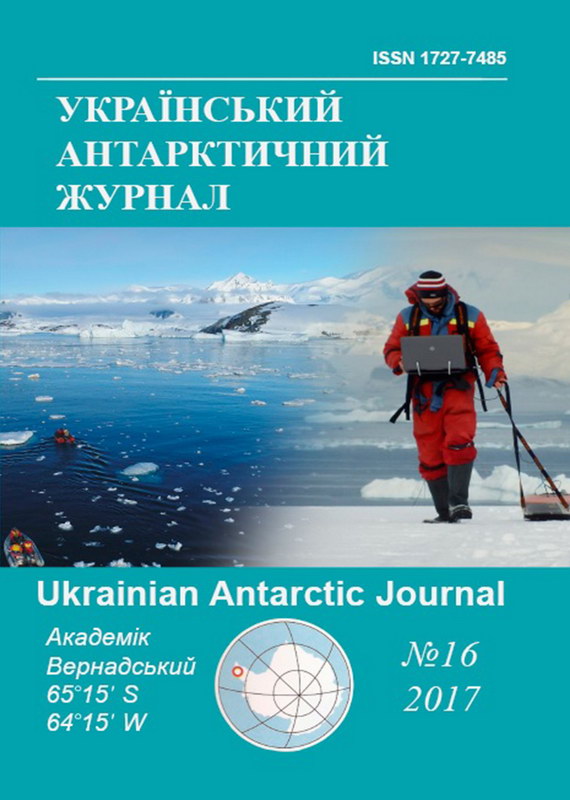Content of low-molecular-weight organic compounds in soils under Deschampsia antarctica and D. cespitosa (Poaceae)
- Desсhampsia antarctica,
- Desсhampsia cespitosa,
- low-molecular-weight organic compounds,
- phenols,
- water-soluble organic matter

This work is licensed under a Creative Commons Attribution-NonCommercial-NoDerivatives 4.0 International License.
Abstract
Antarctic hairgrass Desсhampsia antarctica (Poaceae) is an important ecosystem engineer in coastal Antarctica and significantly affects properties and composition of soil organic matter. The objective of this study was to determine content and composition of low-molecular-weight organic compounds in humus-turf horizon of leptosol under D. antarctica and in alfisol under D. cespitosa. Comparison of soil organic matter under these closely related species is important to find the markers typical for Antarctic soils only. Methods of high-performance liquid chromatography for determination of phenols, phenol carboxylic, phenyl carboxylic, hydroxybenzoic acids, coumarin derivatives and flavonoids were used. Results of this study showed that samples of the humus-sod horizon Hd of the soil under D. antarctica and D. cespitosa had almost similar pH (H2O), pH (CaCl2) and specific electrical conductivity values. Organic carbon content in soils under D. antarctica and D. cespitosa differed insignificantly – from 101 to 114 mg∙g-1. The investigated soils contain approximately the same amount of phenols and phenol carboxylic acids, as well as hydroxybenzoic acid. At the same time, less phenyl carboxylic acids and much less flavonoids were detected in the soil under D. cespitosa. In addition, there were no coumarin derivatives under D. cespitosa, but about 50 μg∙g-1 of these substances were found in initial Antarctic soil. All the classes of organic substances mentioned above are biologically active and can significantly affect soil and determine different processes in it. Thus, it can be concluded that observed differences were probably caused not only by environmental conditions but by the life cycle of D. antarctica. High content of phenyl carboxylic acids and coumarin derivatives in soil under this plant species indicates different pattern of transformation of soil organic matter; however further studies are required to support this idea.
References
- Bedernichek, T., Hamkalo, Z. 2014. Soil labile organic matter: theory, methodology, indicative role. Kyiv: Condor.
- Viter, A. V. 2016. The topical issues of ecosystem metabolism. Kyiv: Naukova Dumka
- Zaimenko, N., Bedernichek, T. Schwartau, V., Mykhalska, L., Khoetskyy, P. 2016. Initial soil formation in coastal Antarctica: do non-ornotogenic soils exist? Ukrainian Antarctic Journal, 15, 170-175.
- Zaimenko, N. V. 2008. Scientific principles of structural and functional design of artificial biogeocenosis in the system soil-plant-soil. Kyiv: Naukova Dumka.
- Karelin, D.V., Zamolodchikov, D.G. 2008. Carbon exchange in cryogenic ecosystems. Moscow: Nauka.
- Kovalev, I. V., Kovaleva, N.O. 2016. Pool of lignin phenols in soils of forest ecosystems. Russian Journal of Forest Science, 2, 148-160.
- Poronnik, O.O., Parnikoza, I.Yu., Miryuta, N.Yu., Myryuta, G.Yu., Grahov, V.P., Navrotska, D.O., Kunakh, V.A. 2017. Deschampsia antarctica E. Desv. plants with different chromosome number cultivated in vitro. Leaves ength and flavanoids in vitro culture and nature. Factors in Experimental Evolution of Organisms, 20, 310-313.
- Roshal, A.D., Krasnopiorova, A.P., Dykyy, I.V., Sizova, Z.A., Yukhno, G.D., Shmyrov, D.V., Gamulya, Yu.G., Utevsky, A.Yu. 2013. Primitive soils of the Mount Demaria (Graham Land, Antarctic Peninsula): morphology, mineral composition, vertical distribution. Ukrainian Antarctic Journal, 13, 265-281.
- Barcikowski, A., Czapiewska, J., Loro, P., Łyszkiewicz, A., Smykla, J., Wojciechowski, A. 2003. Ecological variability of Deschampsia antarctica in the area of Admirality Bay (King George Island, Maritime Antarctic). In: L. Frey (ed.) problems of grass biology. Kraków: 383-396.
- Hamkalo, Z., Bedernichek, T. 2014. Total, cold and hot water extractable organic carbon in soil profile: impact of land-use change. Zemdirbyste-Agriculture, 101 (2), 125-132. https://doi.org/10.13080/z-a.2014.101.016.
- Jones, C.G., Lawton, J.H., Shachak, M. 1994. Organisms as ecosystem engineers. Oikos, 69, 373-386. https://doi.org/10.2307/3545850
- Kuzyakov, Y., Blagodatskaya, E. 2015. Microbial hotspots and hot moments in soil: concept & review. Soil Biology and Biochemistry. 83, 184-199. https://doi.org/10.1016/j.soilbio.2015.01.025.
- Min, K., Freeman, C., Kang, H., Choi, S.U. 2015. The regulation by phenolic compounds of soil organic matter dynamics under a changing environment. BioMed research international, https://doi.org/10.1155/2015/825098.
- Parnikoza, I. Y., Miryuta, N. Y., Maidanyuk, D. N., Loparev, S. A., Korsun, S. G., Budzanivska, I. G., ShevchenkoT.P., Polischuk, V.P., Kunakh, V.A., Kozeretska, I. A. 2007. Habitat and leaf cytogenetic characteristics of Deschampsia antarctica Desv. in the Maritime Antarctica. Polar Science, 1(2-4), 121-128. https://doi.org/10.1016/j.polar.2007.10.002.
- Parnikoza I., Abakumov E., Korsun S., Klymenko I., Netsyk M., Kudinova A., Kozeretska I. 2016. Soils of the Argentine Islands, Antarctica: Diversity and Characteristics. Polarforschung, 86 (2), 83-96.
- Partyka, T., Hamkalo, Z. 2010. Estimation of oxidizing ability of organic matter of forest and arable soil. Zemdirbyste-Agriculture, 97 (1), 33-40.
- Rice, E. L. 1984. Allelopathy. London: Academic Press

